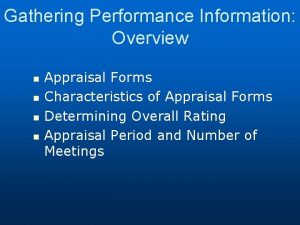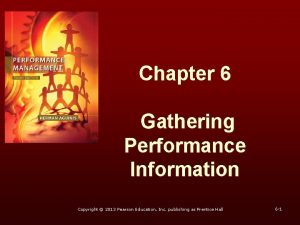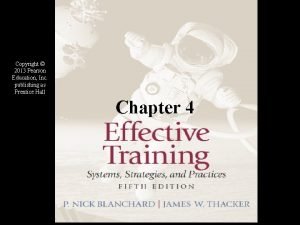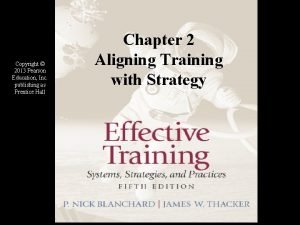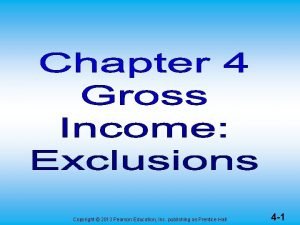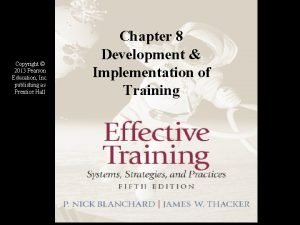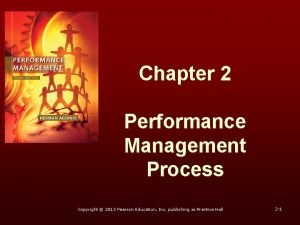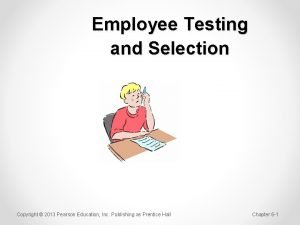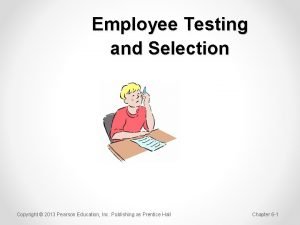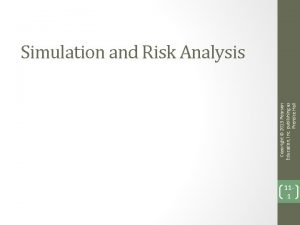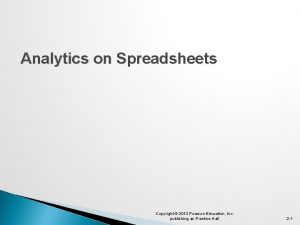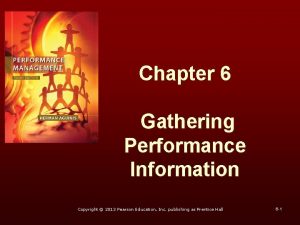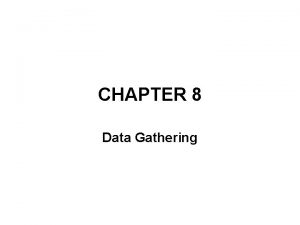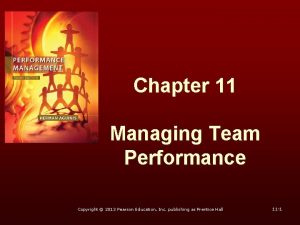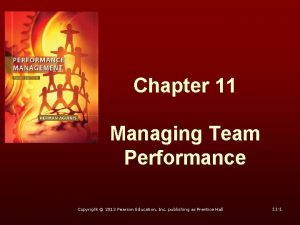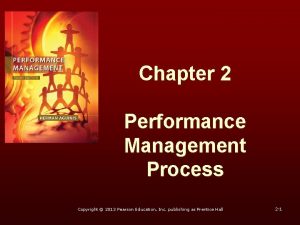Chapter 6 Gathering Performance Information Copyright 2013 Pearson



































- Slides: 35

Chapter 6 Gathering Performance Information Copyright © 2013 Pearson Education, Inc. publishing as Prentice Hall 6 -1

Overview n Appraisal Forms n Characteristics of Appraisal Forms n Determining Overall Rating n Appraisal Period and Number of Meetings Copyright © 2013 Pearson Education, Inc. publishing as Prentice Hall 6 -2

Overview (Continued) n n n Who Should Provide Performance Information? A Model of Rater Motivation Preventing Rating Distortion through Rater Training Programs Copyright © 2013 Pearson Education, Inc. publishing as Prentice Hall 6 -3

Appraisal Forms: Nine Major Components 1. Basic Employee Information 2. Signatures Copyright © 2013 Pearson Education, Inc. publishing as Prentice Hall 6 -4

Appraisal Forms: Nine Major Components (Continued) 3. Accountabilities, Objectives, and Standards 4. Competencies and Indicators 5. Major Achievements and Contributions 6. Stakeholder Input 7. Employee Comments Copyright © 2013 Pearson Education, Inc. publishing as Prentice Hall 6 -5

Appraisal Forms: Nine Major Components (Continued) 8. Developmental Achievements 9. Developmental • Needs • Plans • Goals Copyright © 2013 Pearson Education, Inc. publishing as Prentice Hall 6 -6

Appraisal Forms: Eight Desirable Features 1. Simplicity 2. Relevancy 3. Descriptiveness 4. Adaptability Copyright © 2013 Pearson Education, Inc. publishing as Prentice Hall 6 -7

Appraisal Forms: Eight Desirable Features (Continued) 5. Comprehensiveness 6. Definitional Clarity 7. Communication 8. Time Orientation Copyright © 2013 Pearson Education, Inc. publishing as Prentice Hall 6 -8

Determining Overall Rating n Judgmental strategy • Consider every aspect of performance • Arrive at defensible summary n Mechanical strategy • Consider scores assigned to each section • Add weighted scores to obtain overall scores Copyright © 2013 Pearson Education, Inc. publishing as Prentice Hall 6 -9

Open-Ended (Comments) Sections Challenges n Difficult to systematically categorize and analyze n Quality, length, and content vary Tools to overcome challenges n Computer-aided text analysis (CATA) software n Establish goals of information provided n Training in systematic and standardized rating skills Copyright © 2013 Pearson Education, Inc. publishing as Prentice Hall 6 -10

Appraisal Period Number of Meetings n Annual • May not provide sufficient opportunity for supervisor/employee discussion n Semi-annual n Quarterly Copyright © 2013 Pearson Education, Inc. publishing as Prentice Hall 6 -11

When Review Is Completed Anniversary date n n Supervisor doesn’t have to fill out forms for all employees at the same time Can’t tie rewards to fiscal year Fiscal year n Rewards tied to fiscal year n Goals tied to corporate goals n May be burden to supervisor, depending on implementation Copyright © 2013 Pearson Education, Inc. publishing as Prentice Hall 6 -12

Six Types of Formal Meetings (Can Be Combined) 1. System Inauguration 2. Self-Appraisal 3. Classical Performance Review 4. Merit/Salary Review 5. Development Plan 6. Objective Setting Copyright © 2013 Pearson Education, Inc. publishing as Prentice Hall 6 -13

Who Should Provide Performance Information? Employees should be involved in selecting n Which sources evaluate n Which performance dimensions When employees are actively involved n Higher acceptance of results n Perception that system is fair Copyright © 2013 Pearson Education, Inc. publishing as Prentice Hall 6 -14

Who Should Provide Performance Information? Direct knowledge of employee performance n Supervisors n Peers n Subordinates n Self n Customers Copyright © 2013 Pearson Education, Inc. publishing as Prentice Hall 6 -15

Supervisors Advantages n Can evaluate performance vs. strategic goals n Make decisions about rewards n Able to differentiate among performance dimensions n Viewed as exclusive source in some cultural contexts Disadvantages n n Supervisor may not be able to directly observe performance Evaluations may be biased Copyright © 2013 Pearson Education, Inc. publishing as Prentice Hall 6 -16

Peers Advantages n Assess teamwork Disadvantages n Possible friendship bias n May be less discriminating n Context effects Copyright © 2013 Pearson Education, Inc. publishing as Prentice Hall 6 -17

Subordinates Advantages n n Accurate when used for developmental purposes Good position to assess some competencies Disadvantages n n Inflated when used for administrative purposes May fear retaliation (confidentiality is key) Copyright © 2013 Pearson Education, Inc. publishing as Prentice Hall 6 -18

Self Advantages n n n Increased acceptance of decisions Decreased defensiveness during appraisal interview Good position to track activities during review period Disadvantages n May be more lenient and biased Copyright © 2013 Pearson Education, Inc. publishing as Prentice Hall 6 -19

Self (Continued) Suggestions to improve quality of selfappraisals n n Use comparative instead of absolute measurement systems Allow employees to practice their selfappraisals n Ensure confidentiality n Emphasize the future Copyright © 2013 Pearson Education, Inc. publishing as Prentice Hall 6 -20

Customers (External and Internal) Advantages n Employees become more focused on meeting customer expectations. Disadvantages n Time n Money Copyright © 2013 Pearson Education, Inc. publishing as Prentice Hall 6 -21

Disagreement Across Sources n n Expect disagreements Ensure employee receives feedback by source Assign differential weights to scores by source, depending on importance Ensure employees take active role in selecting which sources will rate which dimensions Copyright © 2013 Pearson Education, Inc. publishing as Prentice Hall 6 -22

Types of Rating Errors n Intentional errors • Rating inflation • Rating deflation n Unintentional errors • Due to complexity of task Copyright © 2013 Pearson Education, Inc. publishing as Prentice Hall 6 -23

A Model of Rater Motivation Expected Positive and Negative Consequences of Rating Accuracy Motivation to Provide Accurate Ratings Probability of Experiencing Positive and Negative Consequences Rating Behavior Expected Positive and Negative Consequences of Rating Distortion Motivation to Distort Ratings Probability of Experiencing Positive and Negative Consequences Copyright © 2013 Pearson Education, Inc. publishing as Prentice Hall 6 -24

Motivations for Rating Inflation • Maximize merit raise/rewards • Encourage employees • Avoid creating written record • Avoid confrontation with employees • Promote undesired employees out of unit • Make manager look good to his/her supervisor Copyright © 2013 Pearson Education, Inc. publishing as Prentice Hall 6 -25

Motivations for Rating Deflation • Shock employees • Teach a lesson • Send a message to employee • Build a written record of poor performance Copyright © 2013 Pearson Education, Inc. publishing as Prentice Hall 6 -26

Reducing Intentional Rating Distortion Recommendations: n n Have raters justify their ratings in a faceto-face meeting Copyright © 2013 Pearson Education, Inc. publishing as Prentice Hall 6 -27

Preventing Rating Distortion Through Rater Training Programs Copyright © 2013 Pearson Education, Inc. publishing as Prentice Hall 6 -28

Rater Training Programs Should Cover: n Information n Motivation n n Identifying, observing, recording and evaluating performance How to interact with employees when they receive performance information Copyright © 2013 Pearson Education, Inc. publishing as Prentice Hall 6 -29

Information—How the System Works n n Reasons for implementing the performance management system Information on the appraisal form and system mechanics Copyright © 2013 Pearson Education, Inc. publishing as Prentice Hall 6 -30

Motivation—What’s in It for Me? n Benefits of providing accurate ratings n Tools for providing accurate ratings Copyright © 2013 Pearson Education, Inc. publishing as Prentice Hall 6 -31

Identifying, Observing, Recording, and Evaluating Performance n n n How to identify and rank job activities How to observe, record, and measure performance How to minimize rating errors Copyright © 2013 Pearson Education, Inc. publishing as Prentice Hall 6 -32

How to Interact with Employees When They Receive Performance Information n How to conduct an appraisal interview n How to train, counsel, and coach Copyright © 2013 Pearson Education, Inc. publishing as Prentice Hall 6 -33

Quick Review n Appraisal Forms n Characteristics of Appraisal Forms n Determining Overall Rating n Appraisal Period and Number of Meetings n Who Should Provide Performance Information? n A Model of Rater Motivation n Preventing Rating Distortion Through Rater Training Programs Copyright © 2013 Pearson Education, Inc. publishing as Prentice Hall 6 -34

All rights reserved. No part of this publication may be reproduced, stored in a retrieval system, or transmitted, in any form or by any means, electronic, mechanical, photocopying, recording, or otherwise, without the prior written permission of the publisher. Printed in the United States of America. Copyright © 2013 Pearson Education, Inc. publishing as Prentice Hall 6 -35
 9 major components of appraisal forms
9 major components of appraisal forms Gathering performance information
Gathering performance information Mbti personal impact report
Mbti personal impact report 2013 pearson education inc
2013 pearson education inc 2013 pearson education inc
2013 pearson education inc Performance gap
Performance gap 2013 pearson education inc
2013 pearson education inc 2013 pearson education inc
2013 pearson education inc 2013 pearson education inc
2013 pearson education inc 2013 pearson education inc
2013 pearson education inc 2013 pearson education inc
2013 pearson education inc 2013 pearson education inc
2013 pearson education inc 2013 pearson education inc
2013 pearson education inc 2013 pearson education inc. answers
2013 pearson education inc. answers Employee testing and selection
Employee testing and selection 2013 pearson education inc
2013 pearson education inc 2013 pearson education inc
2013 pearson education inc 2017 pearson education ltd
2017 pearson education ltd Copyright pearson education inc
Copyright pearson education inc 2010 pearson education inc
2010 pearson education inc Copyright 2009 pearson education inc
Copyright 2009 pearson education inc 2018 pearson education inc
2018 pearson education inc Copyright 2014 pearson education inc
Copyright 2014 pearson education inc Copyright 2010 pearson education inc
Copyright 2010 pearson education inc Copyright 2010 pearson education inc
Copyright 2010 pearson education inc Copyright by pearson education inc. answers
Copyright by pearson education inc. answers Copyright 2003 pearson education inc
Copyright 2003 pearson education inc 2005 pearson prentice hall inc
2005 pearson prentice hall inc Copyright 2009 pearson education inc
Copyright 2009 pearson education inc Copyright pearson education inc
Copyright pearson education inc Copyright 2010 pearson education inc
Copyright 2010 pearson education inc Copyright 2010 pearson education inc
Copyright 2010 pearson education inc Copyright 2010 pearson education inc
Copyright 2010 pearson education inc Copyright 2010 pearson education inc
Copyright 2010 pearson education inc Copyright 2010 pearson education inc
Copyright 2010 pearson education inc Composition copyright example
Composition copyright example
